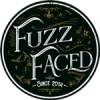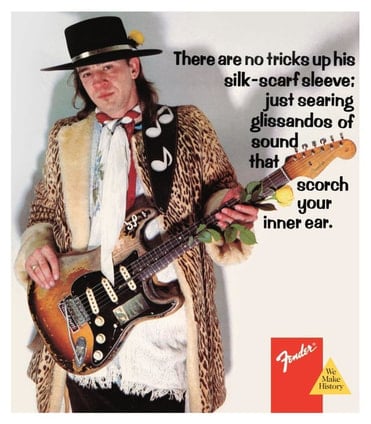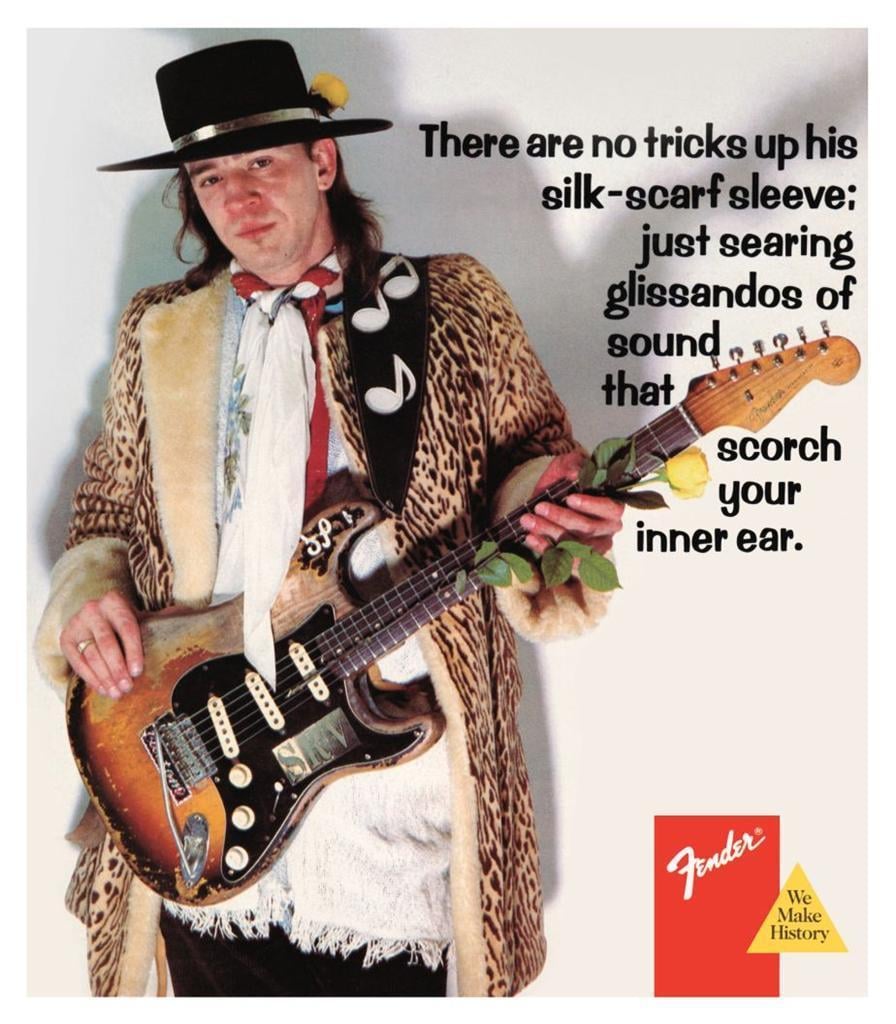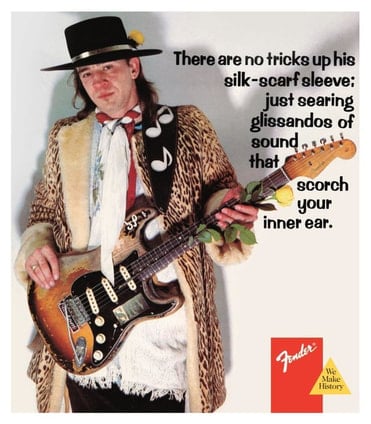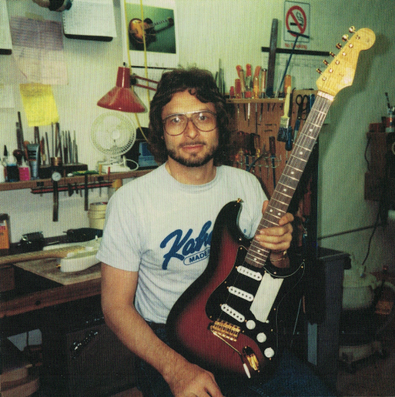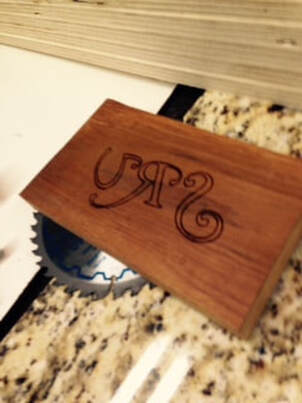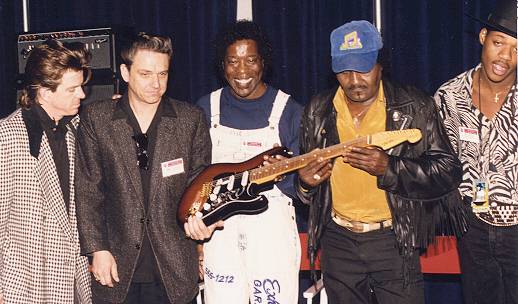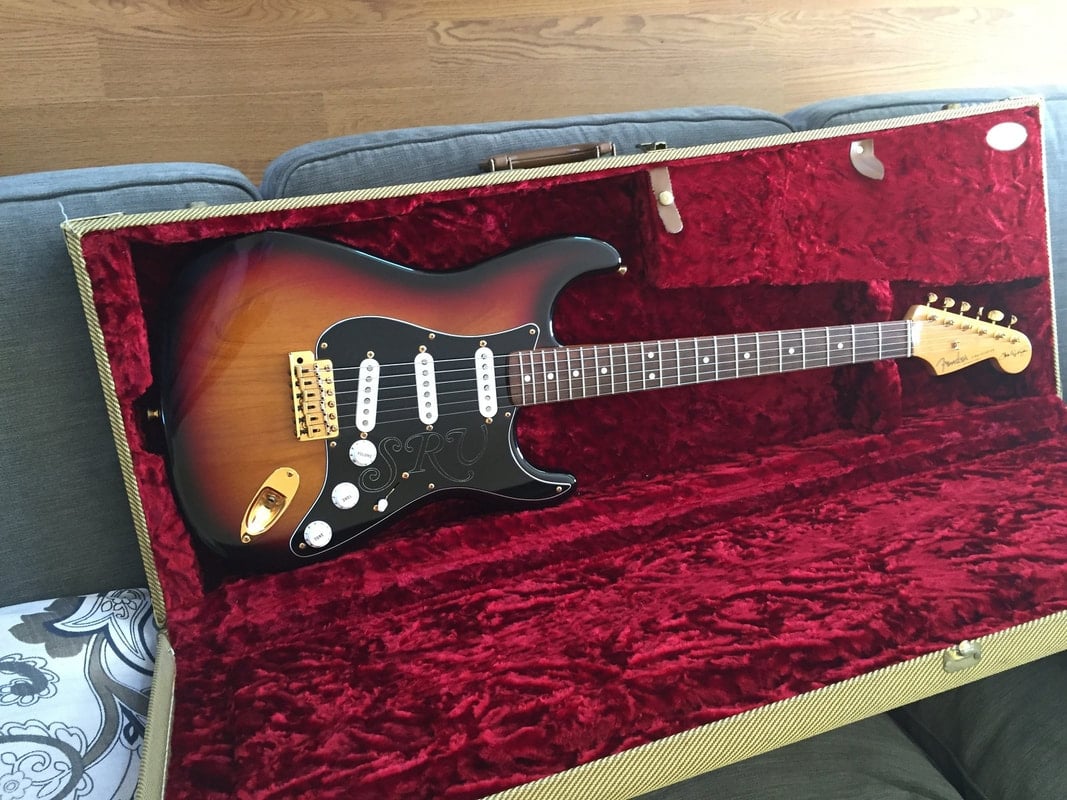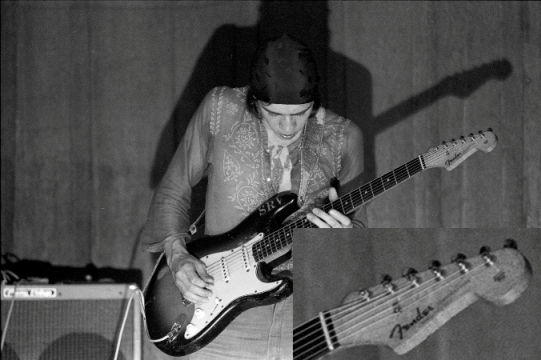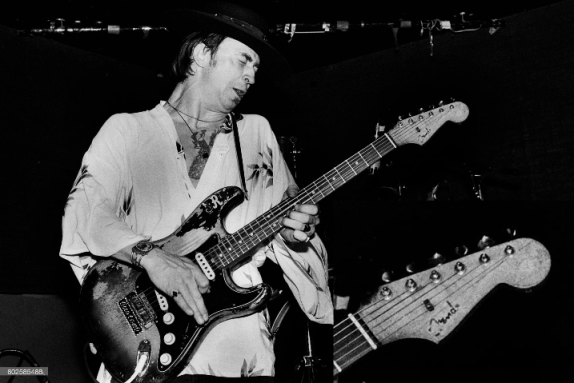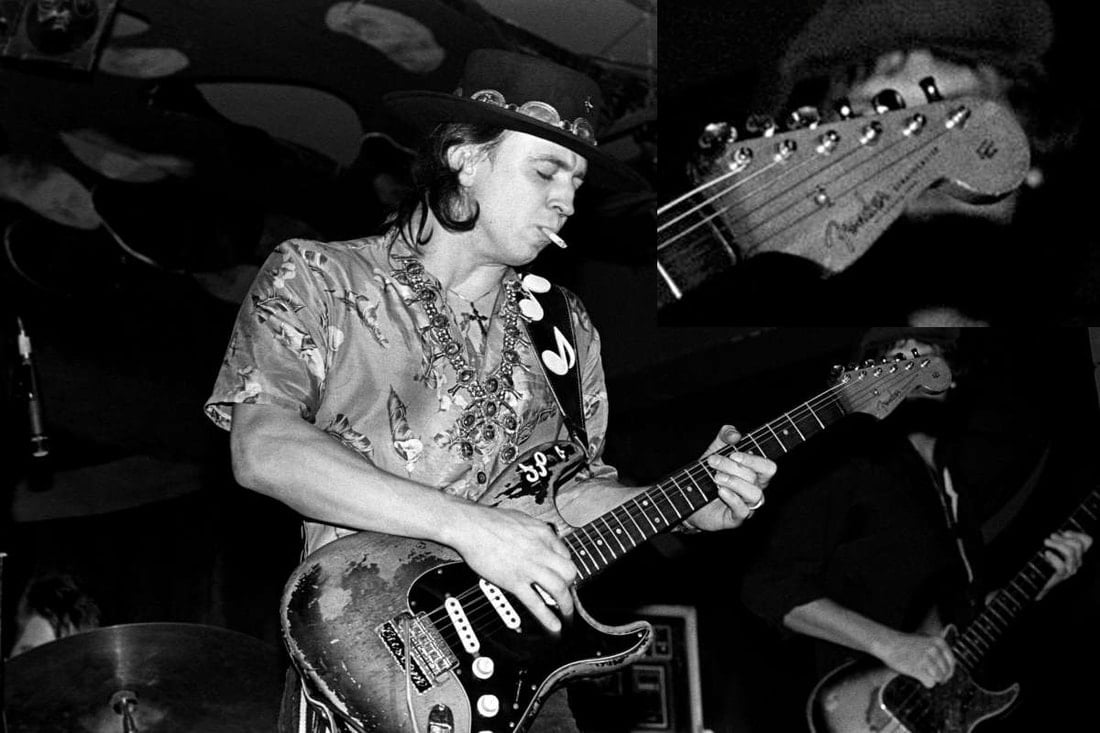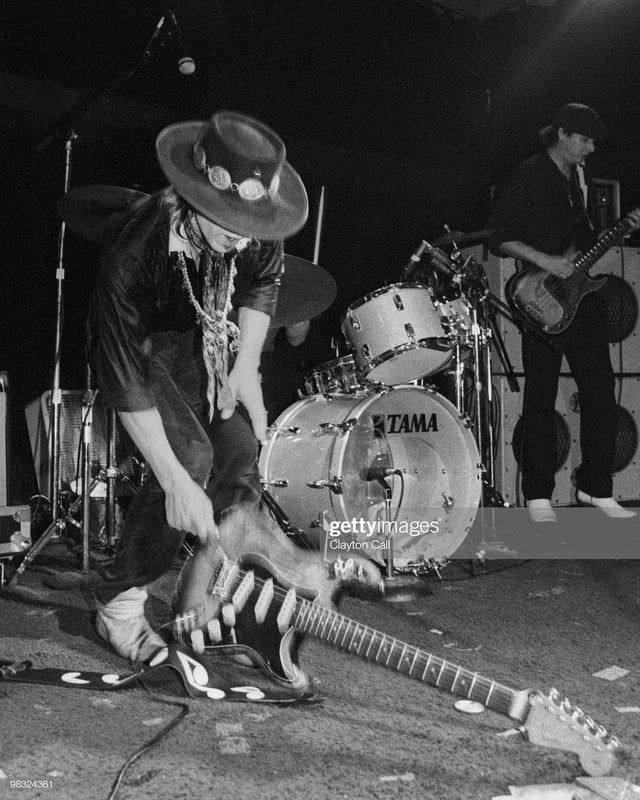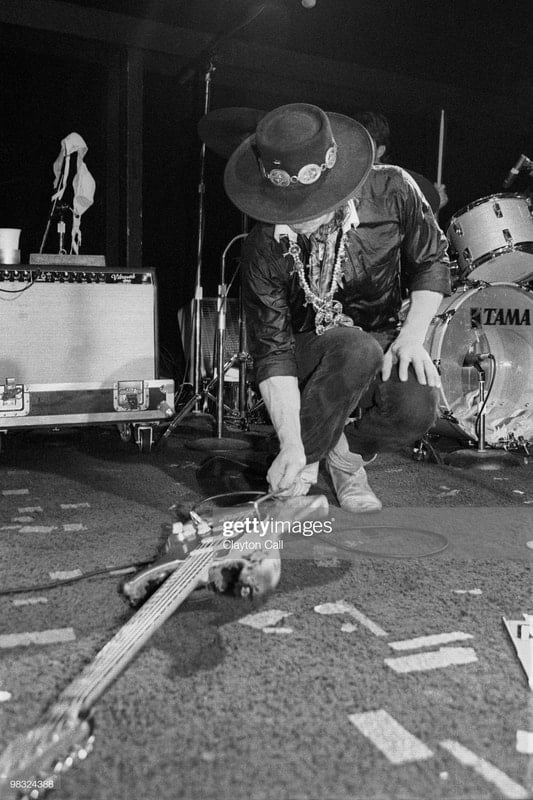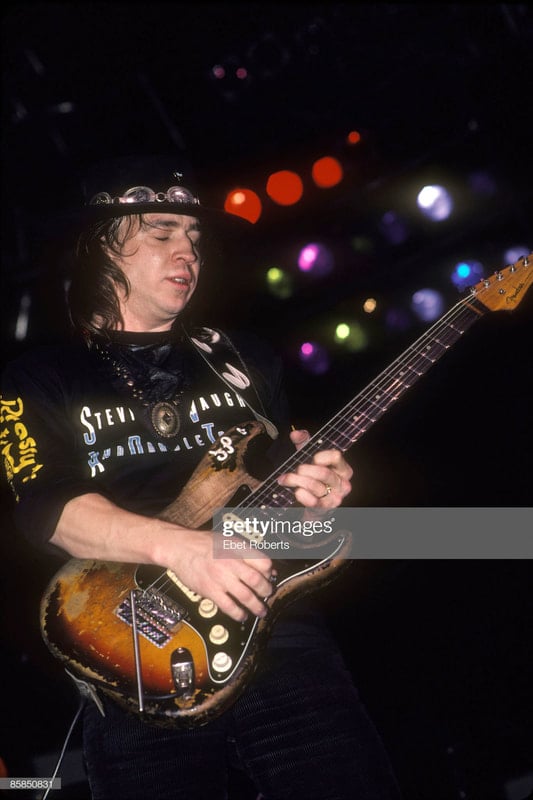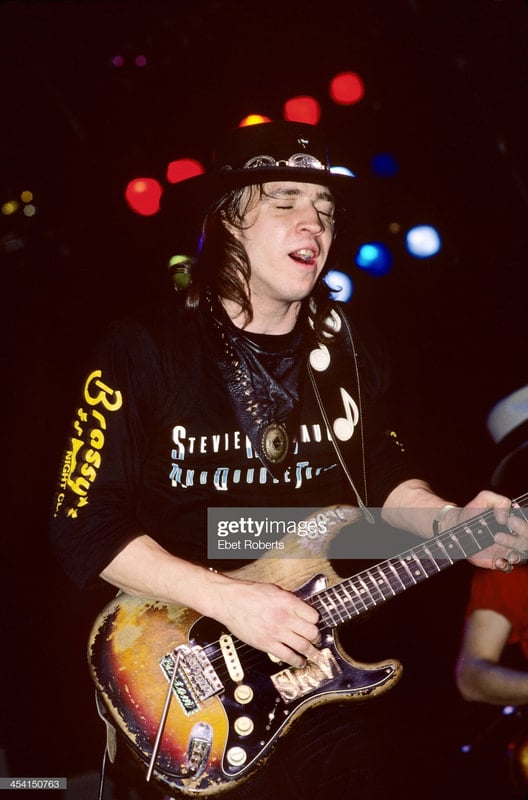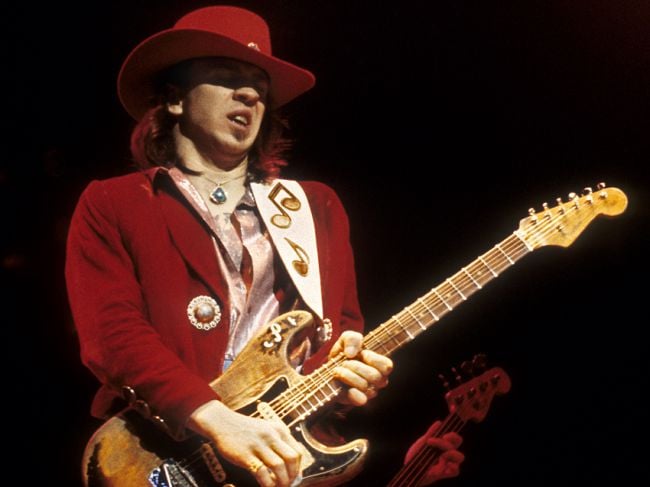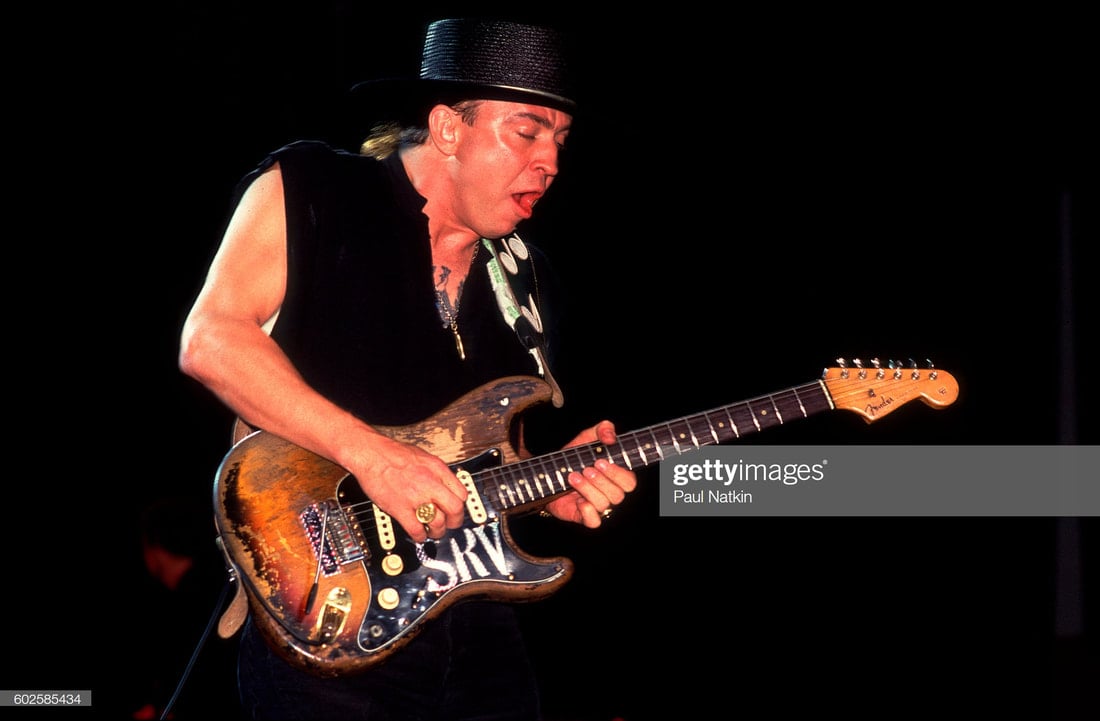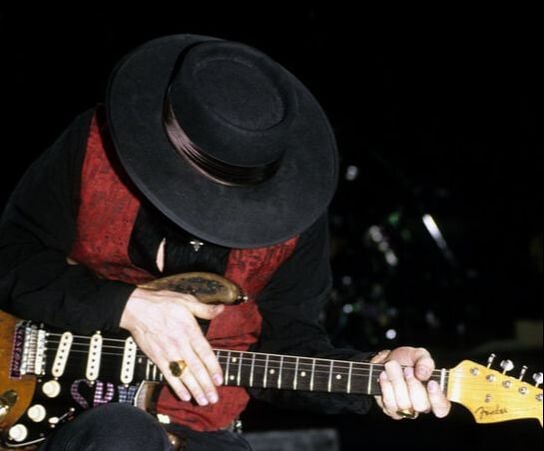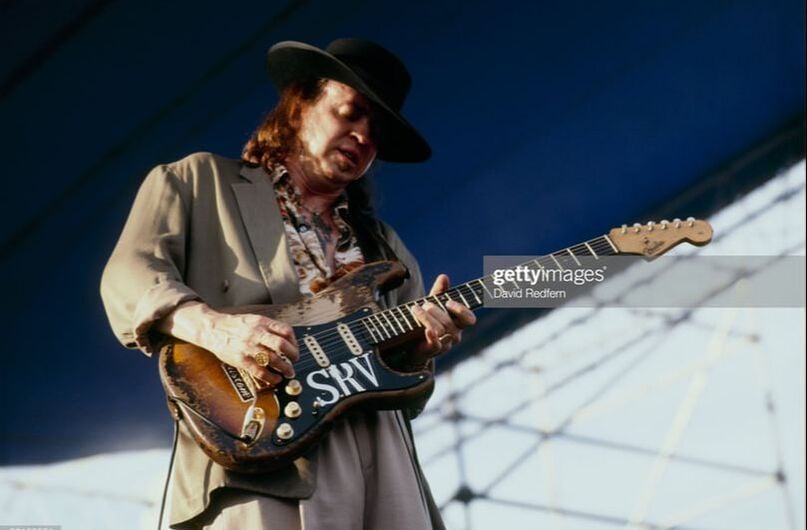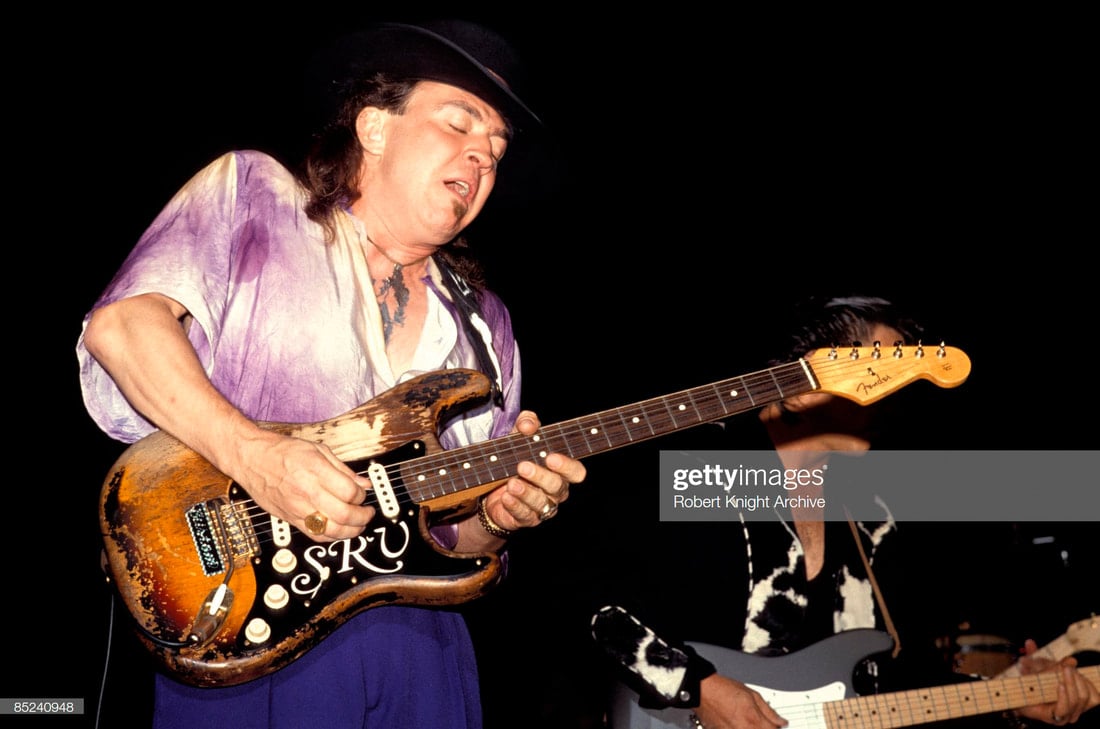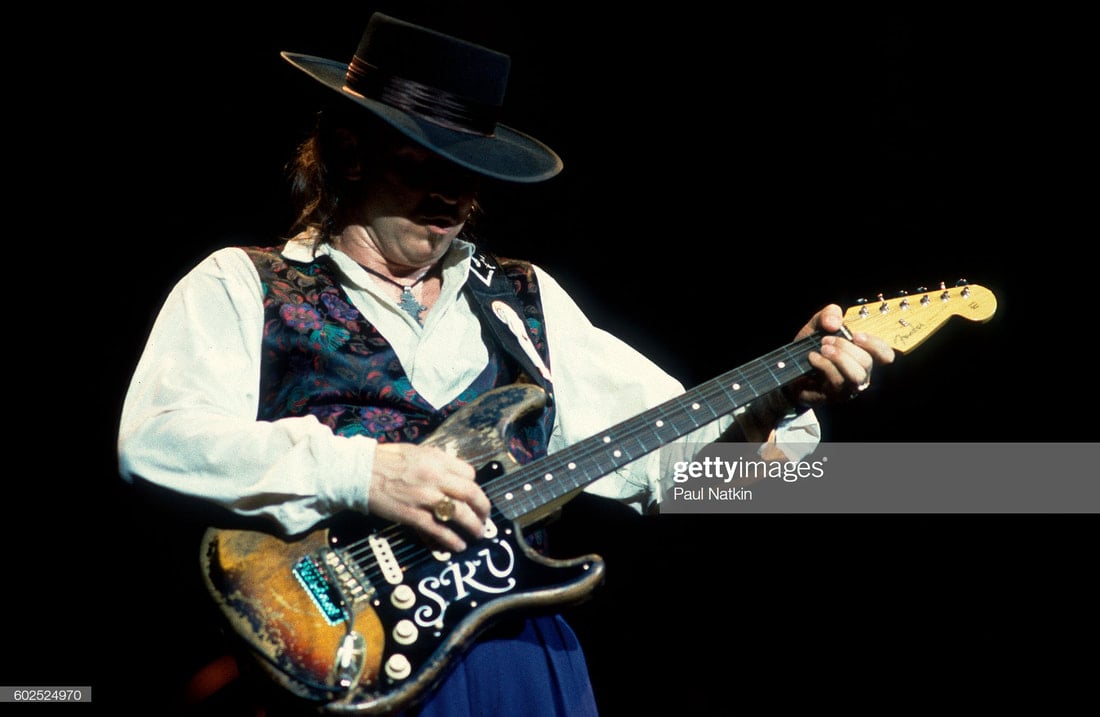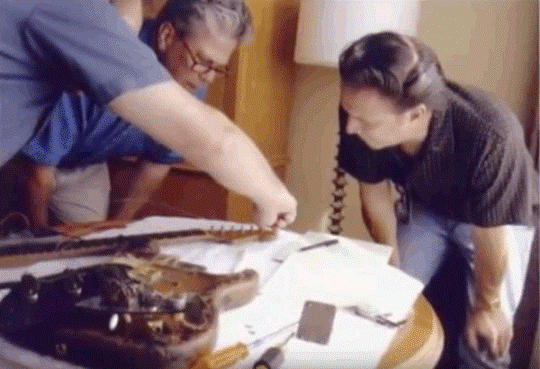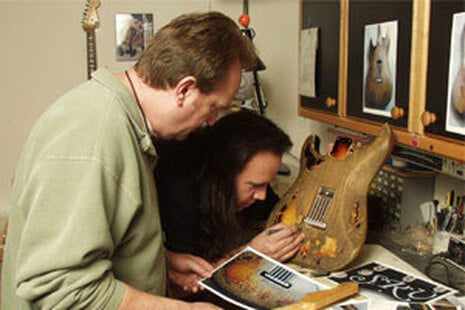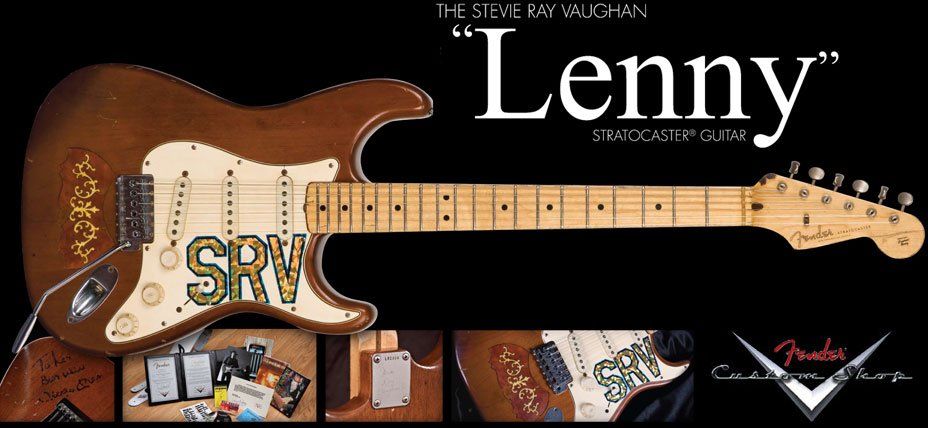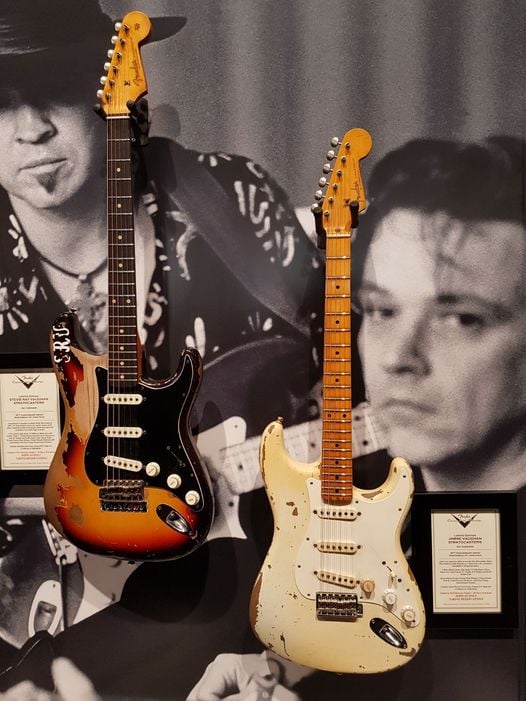The origin of the SRV Signature stratocaster
|
Fender started to design the Stevie Ray Vaughan Stratocaster in the late '80s, but work on the new guitar went slower than expected and the launch of the signature was delayed and finally abandoned after Stevie Ray Vaughan’s tragic death on August 27, 1990. In 1991 his brother Jimmie Vaughan resumed contact with Fender and began to deal personally with the conclusion of the SRV Stratocaster project.
The new guitar was finally unveiled in January 1992 at NAMM in Los Angeles, as a tribute to the king of the Texas blues, about a year and a half after his death. Obviously, the starting point for the 1992 signature was the sunburst Stratocaster of the Dallas musician known as Number One (or First Wife). At the beginning of 1990 Custom Shop Master Builder Larry Brooks dealt with the development of the Stevie Ray Vaughan Stratocaster. |
The prototype of this signature involved the use of the Wilkinson Roller Nut like the one utilized by Jeff Beck, which had aroused the interest of the Texan guitarist, but as Stevie played it very little in public, when launching the guitar Fender decided to use the classic strat nut.
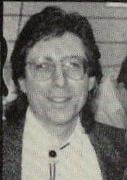 Mark Wittenberg
Mark Wittenberg
Larry Brooks and Mark Wittenberg, who was working in Artist Relations for Fender, presented the first of these prototypes (made by the Custom Shop) to Stevie during one of his last television appearances, on Jay Leno's Tonight Show on July 6, 1990. In an interview with Hittin 'EZine, René Martinez, technician of the Texan guitarist since 1985, remembers that the prototype’s pickguard was devoid of the stickers showing the initials SRV in large, shiny characters, which Stevie used to apply on the Number One, thus causing the guitarist's disappointment. Then, a guy who worked for the program said: “The graphics department is upstairs, what do you need?” And in a short time he returned with a sticker representing the three famous letters, but in a new style, calligraphic and white, which Stevie Rey liked very much and adopted for the pickguard of his SRV Signature Stratocaster, which was engraved by Louis Alegre. Louis is also known because he was involved in the Harley Davidson 90th Anniversary Stratocaster project.
The Stevie Ray Vaughan Stratocaster, unveiled in 1992, featured gold hardware, the left-handed vintage style synchronized tremolo with right-handed tremolo arm, and three Custom Shop Texas Special single coil pickups with cloth wires.
The body was composed of two pieces of alder perfectly juxtaposed along the midline. The polyurethane 3-Color Sunburst finish showed the grain of the wood slightly.
The three-layered black-white-black eight screw pickguard was engraved with the SRV initials and internally shielded by a thin aluminum sheet that covered the pickup area.
The '50s style gloss tinted headstock sported the Stevie Ray Vaughan’s signature and the Spaghetti Logo.
The Thick Oval neck shape, not present in any other modern factory Stratocaster, resembled that of the guitars of the first '60s: thick and with a section very close to a semicircle; however, its contour was asymmetrical as it was more rounded at the top.
The body was composed of two pieces of alder perfectly juxtaposed along the midline. The polyurethane 3-Color Sunburst finish showed the grain of the wood slightly.
The three-layered black-white-black eight screw pickguard was engraved with the SRV initials and internally shielded by a thin aluminum sheet that covered the pickup area.
The '50s style gloss tinted headstock sported the Stevie Ray Vaughan’s signature and the Spaghetti Logo.
The Thick Oval neck shape, not present in any other modern factory Stratocaster, resembled that of the guitars of the first '60s: thick and with a section very close to a semicircle; however, its contour was asymmetrical as it was more rounded at the top.
Brazilian Rosewood and Pau Ferro
The fingerboard was in pau ferro with twenty-one narrow jumbo frets and a light hazel color crossed by dark brown streaks, smooth and particularly flat to be a Stratocaster. Pau ferro is a resistant wood, similar to rosewood in terms of timbre, but more brilliant. However, some of the fretboards of the signatures made in the first year of production were not in pau ferro, but in Brazilian rosewood. Due to the limitations placed by CITES (United Nations Convention on International Trade in Endangered Species of Wild Fauna and Flora) on the felling of Brazilian rosewood trees, Fender began to use pau ferro. Obviously, Brazilian SRV specimens are worth a lot today, but how many are they actually? Someone at Fender claims less than 50, someone else no more than 100. There are even those who believe that no Stevie Ray Vaughan with a Brazilian rosewood fretboard has ever been produced because CITES preceded the construction of the SRV strat. This last viewpoint does not take into consideration that:
- The Brazilian rosewood has been included in CITES protected species in July 1992, while the SRV has been unveiled at NAMM in January 1992 and it was already present in guitar shops in March.
- CITES forbade the cutting of Brazilian rosewood trees but not the use of the wood already cut, which could be regularly reused and commercialized, as long as it had a certificate proving its "pre-convention" origin.
The Custom Artist Model
In 2019 Fender presented the Custom Artist version of the SRV, the Stevie Ray Vaughan Signature Stratocaster. Not very different from the factory model, this guitar distinguished itself for the nitro finish and for the "handwound" pickups, but always Texas Specials. As with the Gilmour signature, the Relic version was also available for the Custom Shop SRV strat, with a Faded 3-Color Sunburst finish.
The "SE" Serial Number Issue
Serial numbers are another cause of confusion: the serial numbers on 1992, 1993 and some early 1994 SRV Stratocasters started with “SE9”, thus suggesting that the guitars in question were made in 1989, while actually the signature was unveiled in 1992! In late '80s Fender indeed ordered a large batch of the "SE" decals. It was likely a mistake. So they used them - and continued using them well into 1993, on all Signature models, including 1992 and 1993 SRV Stratocasters. When the "SE9" prefix decals were used up, in about 1994, Fender started using "SN4", "SN5", "SN6" and so on. Moreover, the prototypes, all made in the Custom Shop, featured, on the neck heel or behind the headstock, the old Custom Shop oval symbol. They also often lacked the "SRV" engraving on the pickguard and frequently had also a Roller Nut.
SRV Number One and False Myths
Number One was Stevie Ray Vaughan’s favorite Stratocaster; it had a round lam Brazilian rosewood fretboard with body dated 1963 and neck 1962, which the musician had purchased in 1973 at Ray Hennig Heart of Texas Music in Austin. It was love at first sight: the old sunburst finish (not yet so worn and lived) had an irresistible charm on Stevie, and its big neck seemed made for his large hands. Stevie Ray (or the previous owner) rewound the pickups, replaced the original frets (first with those of medium size and subsequently with the jumbo ones), replaced the original white pickguard with a black one on which he attached his initials "SRV" and, in 1977, he substituted a gold reverse bridge for the original one, as he was an avid fan of Jimi Hendrix and Otis Rush, who both played with an upside down guitar and with the vibrato bar at the top. In an interview in 1983 Dallas phenomenon declared he used very big strings (.013-0.52, although it seems that he also used a .018-.072!), enough to make Number One unplayable for anyone else.
Ritchie Fliegler and Ted Nugent, who tried it, found the action unmanageable and doing bends impossible. In order to get an idea of what it meant to play with those strings, just think that, when Stevie's fingertips were becoming damaged from them, his technician Renè Martinez convinced him to apply wax (or glue) on the fingertips and, in 1989, to switch to 0.11.
Ritchie Fliegler and Ted Nugent, who tried it, found the action unmanageable and doing bends impossible. In order to get an idea of what it meant to play with those strings, just think that, when Stevie's fingertips were becoming damaged from them, his technician Renè Martinez convinced him to apply wax (or glue) on the fingertips and, in 1989, to switch to 0.11.
Number One neck and body dates
During the years the false myth that Number One featured a body dated 1959 spread. This hoax probably originated from an interview with Stevie by Dan Forte, published in Guitar Player magazine in October 1984, in which he recalled that the writings "LF - 1959" on the body of the guitar and “1962” one on the neck made him imagine, at first, that it was a guitar assembled by Leo Fender himself; but he then realized that the LF initials referred to Louis Fuentes.
To be honest, this statement contrasted a little with Renè Martinez’s claims made to Joe Bosso during an interview for the Music Radar edition of July 2000. Renè said that also the body of the guitar was dated 1962 and that only the pickups were dated 1959; he also recalled that he used to make fun of Stevie: “Hey, it's your guitar, you can call it whatever you want!”
Actually, by analyzing the video about the study of Number One carried out by Richard McDonald, George Blanda and Mike Eldred in 2003 for the purpose of making the replica, it is clear that the body is dated February 1963. “The neck is dated December '62 and the body is '63, but nothing's been changed - we believe the guitar came from the factory like that,” Mike Eldred said in an interview to Barry Cleveland. “The guitar had been re-fretted with bigger frets, probably three or four times. The tuning keys had also been changed. The pickups looked like they were stock, but they had been shielded.” Therefore the pickups, being stock grey bottoms, weren’t dated (hence they couldn’t be dated 1959 as stated by René).
To be honest, this statement contrasted a little with Renè Martinez’s claims made to Joe Bosso during an interview for the Music Radar edition of July 2000. Renè said that also the body of the guitar was dated 1962 and that only the pickups were dated 1959; he also recalled that he used to make fun of Stevie: “Hey, it's your guitar, you can call it whatever you want!”
Actually, by analyzing the video about the study of Number One carried out by Richard McDonald, George Blanda and Mike Eldred in 2003 for the purpose of making the replica, it is clear that the body is dated February 1963. “The neck is dated December '62 and the body is '63, but nothing's been changed - we believe the guitar came from the factory like that,” Mike Eldred said in an interview to Barry Cleveland. “The guitar had been re-fretted with bigger frets, probably three or four times. The tuning keys had also been changed. The pickups looked like they were stock, but they had been shielded.” Therefore the pickups, being stock grey bottoms, weren’t dated (hence they couldn’t be dated 1959 as stated by René).
|
The Number One at Woody Guthrie Center
|
McDonald, Blanda and Mike Eldred inspect Number One
|
The broken neck myth
Many legends and myths circulate also on Number One neck. Some even say that the neck now mounted on the guitar is not the original one. In fact, you can notice in the video shot by the Custom Shop, and also in those produced at the Woody Guthrie Center where the guitar has been exhibited, the absence of the patent numbers and of the "Pat. Pend." decal immediately after the "ORIGINAL Contour Body" one, as would be expected on a '62 headstock. But, by comparing the first two photos of the Number One played by a still young Stevie with that dated 1981, taken at Tuts in Chicago, you can see the Fender logo in 1981 starting to deteriorate and the "ORIGINAL Contour Body Pat.Pend." decal had already disappeared. In the photo taken a few years later, in 1983, at First in New York, decals appear again. The neck was the same (there was the same cigarette burn on the headstock, near the key of the low E): it is evident, therefore, that new decals had been applied on the original neck.
Other photos dated 1983, taken a month later, depict Number One being thrown to the ground by the king of the Texas blues, who in one photo appears worried about the conditions of the headstock. It appears as if some insulating tape was applied as an improvised remedy for minor damage at the base of the headstock. In fact, Mike Eldred, recalling the day they analyzed the guitar to make the replica, said: “We noticed some really peculiar things about the headstock, and eventually realized that the original neck had been repaired.”
Basically the entire headstock was replaced, which is difficult to do on a Fender guitar because it's all cut out from one piece of wood. It's a very intense repair. There was a thin glue line along one side, and they had actually milled-out a piece of the neck and spliced in another piece of wood.” Hence, according to Mike the neck had undergone a delicate restoration work.
Basically the entire headstock was replaced, which is difficult to do on a Fender guitar because it's all cut out from one piece of wood. It's a very intense repair. There was a thin glue line along one side, and they had actually milled-out a piece of the neck and spliced in another piece of wood.” Hence, according to Mike the neck had undergone a delicate restoration work.
August 19, 1983, Keystone Berkeley (Photo by Clayton Call/Redferns). Several pictures show Number One being thrown to the ground. In one picture Stevie seems worried about the headstock. Near the nut, it appears as if there is some insulating tape. Tremolo bar is devoid of tip and switch tip is white. Pickguard has no stickers.
Mike probably had in mind the famous accident at the Garden State Arts Center in Holmdel, New Jersey, on 7 July 1990, occurring 51 days before the guitarist's death. A set piece for the NJ Symphony Orchestra (20'+ long) fell from where it was leaned against the side of the stage and hit the dolly snapping the neck on Number One: “It looked like a Steinberger,” Renè remembers.
However, Martinez declared in an interview with Music Radar that the damaged neck wasn’t the original one: “The neck that was broken wasn't the original Number One neck - I had put that aside to eventually fix, although I never got the time to do that before he died.” Indeed in that interview Renè recalls that Number One neck had become unusable due to the many refrets. For this reason he decided, together with Stevie, to remove it and temporarily mount another neck to replace the fretboard on the original one with ease. Therefore the neck destroyed in the accident wasn’t the original one. And in fact, if you compare the photo of the broken neck taken from Craig Hopkins’s book with that of the Number One in the first ‘80s, you can verify that the cigarette burn is not there. Someone claims that it is that of the “Red” Stratocaster, as in 1986 Stevie mounted a new neck for left-handed on his red Stratocaster, while in the same period three patent numbers reappeared on that of Number One.
René did not want to attempt the complex repairs that Number One required while touring. Therefore, after the Garden State Arts Center accident, Stevie, René and the tour manager Skip Rickert stopped at Manny’s Music in Manhattan, where he picked up a ‘64 Stratocaster Sunburst that he finished the tour with, even though Stevie said he never liked that guitar, so he used Butterscotch and Lenny quite a bit instead. He also used the vintage reissue of his bus driver, Mike Hall, a couple of times on stage.
However, Renè ordered soon a new neck from Fender, which would have been used by Stevie in his last concerts.
So, around the mid ‘80s, Number One had probably changed the neck one or more times, but the one currently on the guitar is the original: worn out fretboard, cigarette burn, meticulous repair of the headstock, non-original decals, everything matches. Indeed Renè did not have time to repair the neck due to Stevie's untimely death, but, as he stated, mounted it after the guitarist’s passing.
However, Martinez declared in an interview with Music Radar that the damaged neck wasn’t the original one: “The neck that was broken wasn't the original Number One neck - I had put that aside to eventually fix, although I never got the time to do that before he died.” Indeed in that interview Renè recalls that Number One neck had become unusable due to the many refrets. For this reason he decided, together with Stevie, to remove it and temporarily mount another neck to replace the fretboard on the original one with ease. Therefore the neck destroyed in the accident wasn’t the original one. And in fact, if you compare the photo of the broken neck taken from Craig Hopkins’s book with that of the Number One in the first ‘80s, you can verify that the cigarette burn is not there. Someone claims that it is that of the “Red” Stratocaster, as in 1986 Stevie mounted a new neck for left-handed on his red Stratocaster, while in the same period three patent numbers reappeared on that of Number One.
René did not want to attempt the complex repairs that Number One required while touring. Therefore, after the Garden State Arts Center accident, Stevie, René and the tour manager Skip Rickert stopped at Manny’s Music in Manhattan, where he picked up a ‘64 Stratocaster Sunburst that he finished the tour with, even though Stevie said he never liked that guitar, so he used Butterscotch and Lenny quite a bit instead. He also used the vintage reissue of his bus driver, Mike Hall, a couple of times on stage.
However, Renè ordered soon a new neck from Fender, which would have been used by Stevie in his last concerts.
So, around the mid ‘80s, Number One had probably changed the neck one or more times, but the one currently on the guitar is the original: worn out fretboard, cigarette burn, meticulous repair of the headstock, non-original decals, everything matches. Indeed Renè did not have time to repair the neck due to Stevie's untimely death, but, as he stated, mounted it after the guitarist’s passing.
The Number One Replica
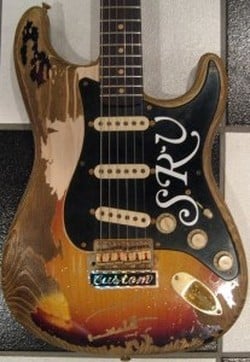 Number One Replica (andybabiuksfabgear.com)
Number One Replica (andybabiuksfabgear.com)
In November 2003 Fender announced that it would produce 100 replicas of Stevie Ray’s favorite guitar, Number One, after a Custom Shop team composed by Richard McDonald, George Blanda and Mike Eldred went to Texas, on September 8, to meet Jimmie Vaughan. The purpose was to inspect Stevie's guitar in the smallest detail, from the output and the type of winding of the pickups to the weight and scratches on the wood. “We will be able to painstakingly reproduce Number One in every way, shape and form”, Eldred said. And he added: “The only thing we can't replicate is his playing: Steve's mojo is not included!”
The 100 Limited Edition Stevie Ray Vaughan Tribute Stratocaster, called Number One Replicas, carefully constructed by Master Builder John Cruz, who had already dealt with the relic Rory Gallagher Tribute Stratocaster, were unveiled in January 2004 and, according to The ToneQuest Report, were all pre-sold at $10,000 each.
After having analyzed videos, photos and notes by McDonald, Blanda and Eldred, John was amazed at the size of the neck, which wasn’t as large as many assumed, but slightly thicker than a classic Oval “C” of the first '60s strats. It was also clear that the fretboard had been refretted many times and that it was much flatter than other early '60s strats. The left-handed bridge led to a new rout for the tremolo bar, while the old one was fitted with a wood dowel.
Cruz declared that this guitar, which took him about six or seven months, probably represented the peak of his career at Fender. The guitars are not numbered from 1 to 100 as the other limited edition Stratocasters, but they follow the typical numbering of John Cruz guitars which is independent of the model made. It seems that the first of the 100 Number One replicas was the JC044 and the last the JC229 and that Jimmie Vaughan had bought three!
The 100 Limited Edition Stevie Ray Vaughan Tribute Stratocaster, called Number One Replicas, carefully constructed by Master Builder John Cruz, who had already dealt with the relic Rory Gallagher Tribute Stratocaster, were unveiled in January 2004 and, according to The ToneQuest Report, were all pre-sold at $10,000 each.
After having analyzed videos, photos and notes by McDonald, Blanda and Eldred, John was amazed at the size of the neck, which wasn’t as large as many assumed, but slightly thicker than a classic Oval “C” of the first '60s strats. It was also clear that the fretboard had been refretted many times and that it was much flatter than other early '60s strats. The left-handed bridge led to a new rout for the tremolo bar, while the old one was fitted with a wood dowel.
Cruz declared that this guitar, which took him about six or seven months, probably represented the peak of his career at Fender. The guitars are not numbered from 1 to 100 as the other limited edition Stratocasters, but they follow the typical numbering of John Cruz guitars which is independent of the model made. It seems that the first of the 100 Number One replicas was the JC044 and the last the JC229 and that Jimmie Vaughan had bought three!
Lenny Tribute Stratocaster
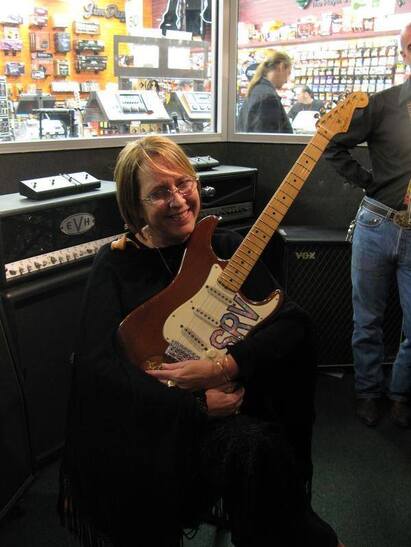 Lenora Bailey, known as "Lenny"
Lenora Bailey, known as "Lenny"
In 2007 Fender Custom Shop Master Builders made 235 replicas of the 1965 Stratocaster which Stevie used to call Lenny, in honor of Lenora Bailey, the guitarist's wife between 1979 and 1988.
Originally, Lenny was a sunburst Stratocaster that had undergone a dark reddish natural amateur refinishing and exhibited a floral inlay on the body, near the bridge. Stevie, still unknown, eyed it for the first time in a shop in Austin and fell in love with it, but he did not have the required $350. His wife took up a collection along with seven friends of the Texan guitarist and gave him the guitar on October 3, 1980, on the occasion of his 26th birthday. That same night, while Lenora was sleeping, Stevie Ray Vaughan wrote the beautiful and famous "Lenny". “I found it at a pawnshop and didn’t have the money to buy it, and my wife and several other friends of mine put a pool together and bought the guitar. It’s always meant a lot to me. And I love what it sounds like. ‘Riviera Paradise’ and ‘Lenny” are both played on the same guitar, and for some reason that guitar works for songs like that more than anything else,” Stevie declared in Guitar Player magazine in 1990.
“To me, he was beautiful, though, and it was beautiful, too,” Lenora said about Lenny and her beloved Stevie. “For me it was so beautiful that it was really hard to listen to him play that song. I had to go to the bathroom because I'd cry every time he played it. It wasn't a sad cry; it was a loving cry.”
Stevie replaced the original neck, which featured a rosewood fretboard, with a Charvel maple neck (that had been made by Mike Eldred, before he went to Fender, for Billy Gibbons) and, more or less in the same period, applied the “SRV” sticker on the pickguard. The autograph of Mickey Mantle, New York Yankees star who in April 1985 had met Stevie at one of his concerts, stood out on the back of the body, and Stevie Ray Vaughan’s signature was engraved on the neck plate.
On June 24, 2004, the same day in which Eric Clapton’s Blackie was put up for auction, Guitar Center bought Lenny for $623,500.
On October 8, 2007, Fender announced that it would produce, in a limited edition of 235 copies, the Stevie Ray Vaughan Lenny Tribute Stratocaster, that was unveiled on December 12, 2007 at a sale price of $17,000. “This guitar had very special meaning to Stevie,” Mike Eldred declared. “He had it throughout his career; he took it everywhere, and during each show, he stopped, sat down on the stage, and played that song, on that guitar. It's like he was holding on to that very special time before he was a star, and just didn’t want to let that part of his life go.”
The copies were all made by Custom Shop master builders, under the supervision of Jason Smith. “I thought, if this guitar could talk, what a story it would tell! I just wonder who owned it first? And, how did it end up in a pawn shop? I was a little nervous to even pick the guitar up, let alone take it apart! It was an honour to work on such a legendary player's instrument,” Jason said.
The Master Builder to guide the project declared that the greatest difficulty was to reproduce the floral inlay near the bridge and the body shape, as it had been sanded further in several places: “One of the major obstacles to overcome was recreating the over-sanded body perimeter. It's quite difficult to over-sand something accurately.”
Also the strap button on the upper horn had a very special diamond shape, out of production for a long time, which was reproduced directly with a machine in the Fender factory. Other features: the brass chrome-plated saddles, the central pickup cavity enlarged to accommodate a humbucker, a circuit in which the two tone knobs were reversed; on the headstock there were obvious signs of repair, a cigarette burn near the bass E key and worn-in string winder impressions. The guitars were sold in a hard shell case showing the words “HURRICANE” on one side and "STEVIE RAY VAUGHAN" on the other. Inside were a copy of the Live from Austin, Texas dvd, a replica of the guitarist's white shoulder strap and other gadgets.
Originally, Lenny was a sunburst Stratocaster that had undergone a dark reddish natural amateur refinishing and exhibited a floral inlay on the body, near the bridge. Stevie, still unknown, eyed it for the first time in a shop in Austin and fell in love with it, but he did not have the required $350. His wife took up a collection along with seven friends of the Texan guitarist and gave him the guitar on October 3, 1980, on the occasion of his 26th birthday. That same night, while Lenora was sleeping, Stevie Ray Vaughan wrote the beautiful and famous "Lenny". “I found it at a pawnshop and didn’t have the money to buy it, and my wife and several other friends of mine put a pool together and bought the guitar. It’s always meant a lot to me. And I love what it sounds like. ‘Riviera Paradise’ and ‘Lenny” are both played on the same guitar, and for some reason that guitar works for songs like that more than anything else,” Stevie declared in Guitar Player magazine in 1990.
“To me, he was beautiful, though, and it was beautiful, too,” Lenora said about Lenny and her beloved Stevie. “For me it was so beautiful that it was really hard to listen to him play that song. I had to go to the bathroom because I'd cry every time he played it. It wasn't a sad cry; it was a loving cry.”
Stevie replaced the original neck, which featured a rosewood fretboard, with a Charvel maple neck (that had been made by Mike Eldred, before he went to Fender, for Billy Gibbons) and, more or less in the same period, applied the “SRV” sticker on the pickguard. The autograph of Mickey Mantle, New York Yankees star who in April 1985 had met Stevie at one of his concerts, stood out on the back of the body, and Stevie Ray Vaughan’s signature was engraved on the neck plate.
On June 24, 2004, the same day in which Eric Clapton’s Blackie was put up for auction, Guitar Center bought Lenny for $623,500.
On October 8, 2007, Fender announced that it would produce, in a limited edition of 235 copies, the Stevie Ray Vaughan Lenny Tribute Stratocaster, that was unveiled on December 12, 2007 at a sale price of $17,000. “This guitar had very special meaning to Stevie,” Mike Eldred declared. “He had it throughout his career; he took it everywhere, and during each show, he stopped, sat down on the stage, and played that song, on that guitar. It's like he was holding on to that very special time before he was a star, and just didn’t want to let that part of his life go.”
The copies were all made by Custom Shop master builders, under the supervision of Jason Smith. “I thought, if this guitar could talk, what a story it would tell! I just wonder who owned it first? And, how did it end up in a pawn shop? I was a little nervous to even pick the guitar up, let alone take it apart! It was an honour to work on such a legendary player's instrument,” Jason said.
The Master Builder to guide the project declared that the greatest difficulty was to reproduce the floral inlay near the bridge and the body shape, as it had been sanded further in several places: “One of the major obstacles to overcome was recreating the over-sanded body perimeter. It's quite difficult to over-sand something accurately.”
Also the strap button on the upper horn had a very special diamond shape, out of production for a long time, which was reproduced directly with a machine in the Fender factory. Other features: the brass chrome-plated saddles, the central pickup cavity enlarged to accommodate a humbucker, a circuit in which the two tone knobs were reversed; on the headstock there were obvious signs of repair, a cigarette burn near the bass E key and worn-in string winder impressions. The guitars were sold in a hard shell case showing the words “HURRICANE” on one side and "STEVIE RAY VAUGHAN" on the other. Inside were a copy of the Live from Austin, Texas dvd, a replica of the guitarist's white shoulder strap and other gadgets.
2018 "Vaughan Brothers" Stratocasters
|
In 2018 the Custom Shop celebrated the two Vaughan brothers with 30 Limited Edition Stevie Ray Vaughan Stratocasters and 30 Limited Edition Jimmie Vaughan Stratocasters, all made by John Cruz and inspired by the guitars used by the two Texas Blues brothers.
Unlike the Number One Replica, this new 2018 “tribute” was based on Stevie’s First Wife in the early years of its existence. The finish was heavy relic and the cigarette burn stood out on the headstock, but this time the pickguard was an eleven-hole one and devoid of the “SRV” stickers (except for the “Custom” near the bridge and the white “SRV” on the upper horn). The synchronized tremolo was still left-handed and there was, on the body, a “patch” also visible on the Number One (and on its replica) as a reminder of the right-handed bridge originally installed on the First Wife, but the hardware was not gold and there weren't patent numbers on the headstock. |
Antonio Calvosa
